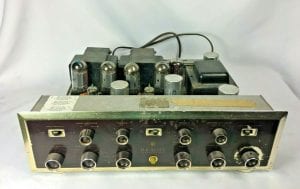

Rather than go through each individual model, one by one, I’m going to pick representative products from each series for more in depth review. While a 310C is different than a 310D, they are similar enough that both need not be discussed in detail. In some cases such as the 330C and 330D, the differences are primarily in the front panels and AM circuits, the FM tube complement and arrangement are identical. While 310s were more expensive than 311s, and 350s were better than 370s, 350s were also better than 314s and 312s. Only a set of price lists, or a chart of when each unit was made, and its’ list price can clarify Scotts’ numerical and alphabetical avalanche of models. While the following chart may seem a bit complicated, it does give a clear idea of what was released when, and is far easier than pouring over the individual yearly price lists from which it was compiled. Scotts’ numbering methodology had almost no logic whatsoever. The 310 series were Scotts’ top-of-the-line tuner models. The last 310, the 310E was made in the last half of 1963, and was the only 310 with built-in multiplex circuitry. All previous 310 models required an outboard multiplex adapter for stereo operation. The fabled 4310 was really a 310 in spirit. The 4310 was made for only one year, 1963, and is the most sought after Scott tuner, with used prices in the $1000 to $1500 range. When you consider it was listed for $480 in 1963, which in 1987 dollars is about $1475, it has just about held its value. It was outrageously expensive in 1963, and in 1987 is still exorbitant. Located tuning meter, beveled edges with rounded corners, and the golden – bronze color) devised by Marketing head Victor Pomper and Sales Manager Marvin Grossman. I figured this will help you keep your beautiful amp reliable as well.Scotts’ first FM tuner, the 310A was introduced in December 1954. It was boxy, 4 1/2 ” by 13″ by 10 1/4″ housed in a metal case. Its 11 tubes all pointed downward. This tuner predates the “Scott Look” (Circular Vernier tuning dial, backlight, and small centrally Lots of low end grunt, very dimensional, and delicate detailed highs. My gut tells me the rectifier tube was on its way out, but with the cans replaced, I'm now confident it's going to be reliable for many years. It's now sounding incredible, seems much more powerful then before, dead quiet. Lots of reading, and advice here, led me to replacing the four can caps, and I bought a pair of Sovtek 5AR4's, they are cheap, for testing once repaired. Mine had been working and sounding great until a year or so ago, started making intermittent rumbling sound (motor boating) which would stop after a half hour or so, but a couple weeks ago at startup, it rumbled, a small spark shot out from the base of the rectifier tune and it shut down. I'd still replace all the original white caps though, and the cans.Ĭheck all tubes. EDIT: I looked more closely at your pics, and it looks like the rectifier was already replaced, and some caps added in there. Recap it, replace the selenium rectifier and add a 33ohm 5v resistor before the rectifier. For preservation, try your best to not touch the face surface. The lettering on the face plate rubs off very easily, especially the numbers around the volume knob since it's the most used. Yours looks just like my 1960 earlier version.Ī couple notes from what I've learned using and restoring mine. Almost all B versions I've seen have a silver face plate and the knobs etc. A question, how do you know it's a "B" version.


 0 kommentar(er)
0 kommentar(er)
